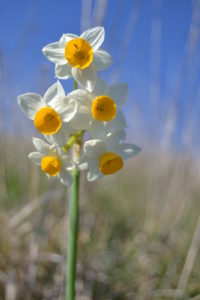Species and habitat description
Narcissus tazetta L. is a bulbous herbaceous plant and belongs to the family of the Amaryllidaceae. It is 20 to 60 cm high, with slightly stiff and fleshy stems, perennial with underground bulbs. The roots are collated and thread-like. The flowers are characterized by a central cup, shaped like a small trumpet, surrounded by a crown consisting of 5-7 petals spread outwards. It grows in wet meadows and sparse wood from 0 to 1400 meters. It flowers from April to May, in southern Italy also between December and March.
It is one of the most celebrated flowers in mythology by the ancient Greeks and the Latins. The most common is that Narcissus was a young son of the Cefiso river and the nymph Liriope. At the age of fifteen, beautiful and ambiguous, he was desired by young men and women, but he rejected them because they were not considered worthy of him. But the hour of punishment came when one of his many lovers implored the gods hoping that he too would fall in love but that he did not possess those who loved him.
One day, chasing a deer, he reflected himself in the water and not recognizing himself, he invaded himself; later he discovered the truth fading in the impossible love so much that he wanted to get out of his body. Until, not deciding to give himself to any suitor, because what he wanted was in him, he died of consumption. When the nymphs began to prepare the coffin and the stake, they realized that the youth’s body had disappeared and a flower with white and yellow petals in the center had blossomed in the place. This story was also described in other ways by Ovid and it was set in Boeotia in the city of Thespis.
Even today with the term narcissus is meant to indicate a person who has a high self-esteem that borders on self-worship.
The term “narkos” “narcosis” is used to indicate a sleep-induced state by means of drugs that lead to sleep. More jokingly it is indicated for a person who, talking about useless things, induces narcosis in his interlocutors.
The narcissus bulbs, but also the leaves, contain narcisin, a poisonous alkaloid.
Major threats
Loss of habitat and anthropic pressure. Narcissus is one of many endangered species due to “herbicides” and monocultures of intensive agriculture. In the Region Emilio-Romagna is a protected species and is included in the list of the Protected Flora (General Conservation measures of Natura 2000 Network, protection of the spontaneous species).
Specific conservation action
The Paperwhite is widespread in the Apennines, included in the site IT4070011 of the Parco della Vena di Gesso. Specific conservation actions include harvesting and storing seeds in order to create a seed bank and preserve ecotypes. If necessary, resettlement of the species. Other actions consists in eliminating invasive alien species, keeping the meadows and opening glades to avoid the succession competition for this species.

Related project areas
Riva di San Biagio
Bibliography
www.actaplantarum.org; http://ambiente.regione.emilia-romagna.it/it/parchi-natura2000/sistema-regionale/flora/flora-protetta; http://www.altovastese.it